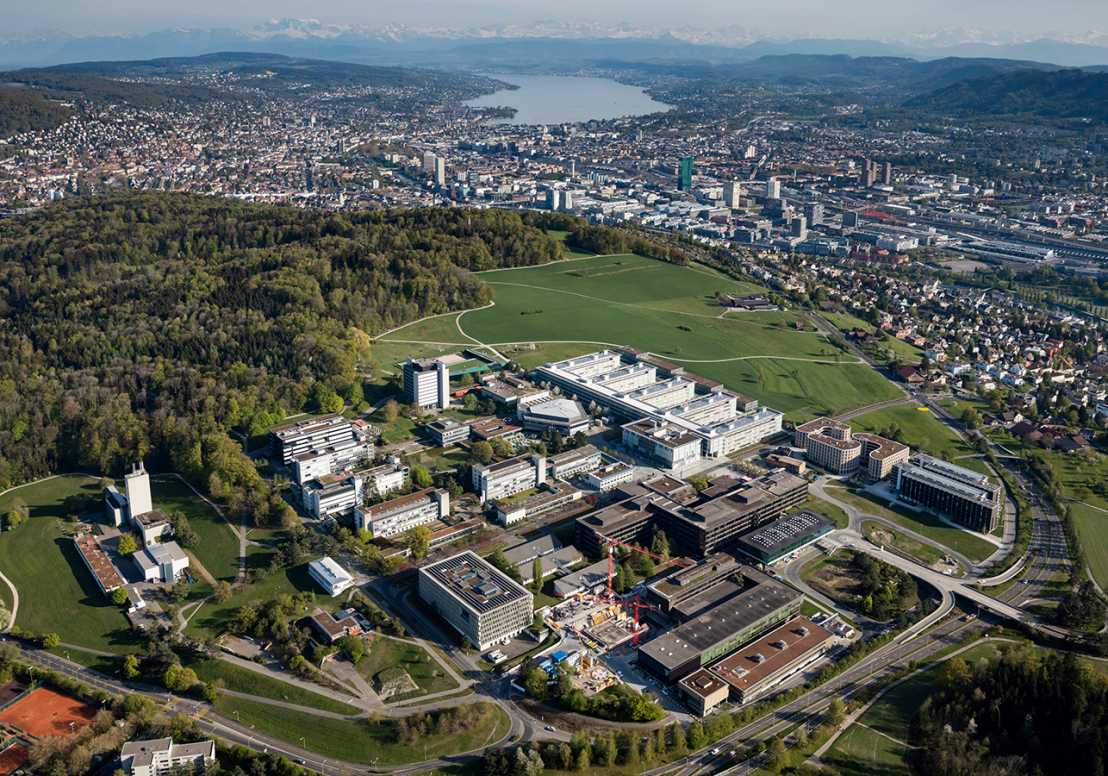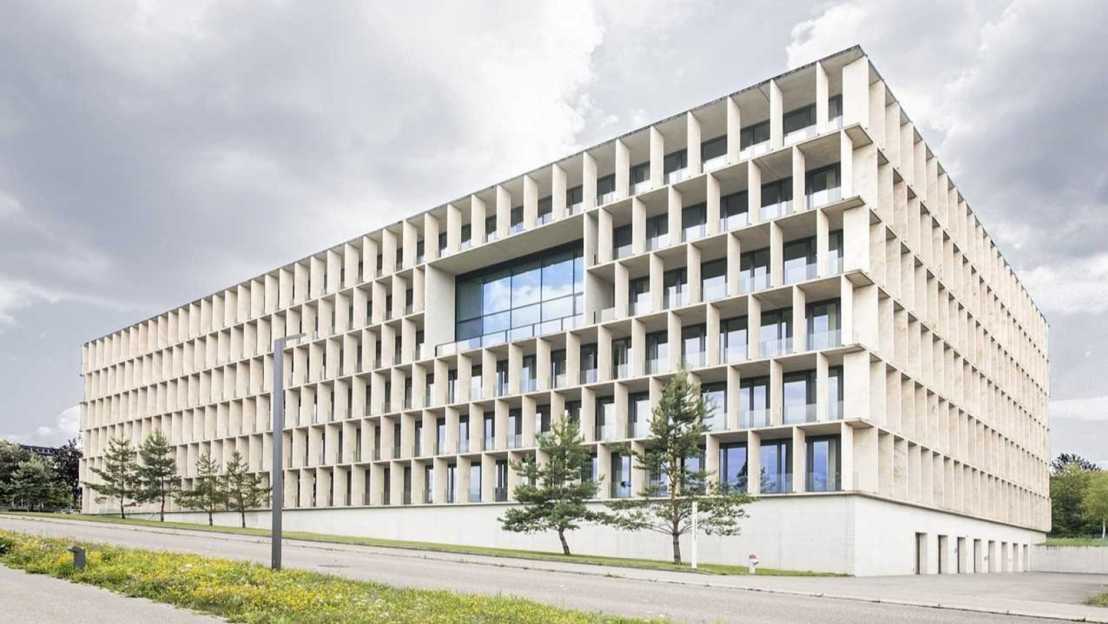Site visits
The conference will be accompanied by site visits of recent, cutting-edge building projects in and around Zurich. The Site Visits will take place on Thursday afternoon, June 26, 2025.
Site Visits can be booked through the online registration process in external page ConfTool.
Please note that the site visits require a minimum participation of 5 people. In case the minimum number is not achieved, you will be optionally assigned to a different site visit.
1 | NEST at Empa

Technological innovations are typically developed in laboratories. However, what works perfectly on a small scale is not always suitable for large-scale implementation. The journey from invention and laboratory development to successful market innovation can be long and filled with challenges. To speed up this innovation process, Empa has established various demonstrators. One of these is NEST - Next Evolution in Sustainable Building Technology, which focuses on the building sector. In this modular research and innovation building, created in collaboration with Eawag, new technologies, materials, and systems are tested, researched, further developed, and validated under real-world conditions. Close cooperation with partners from research, industry, and the public sector helps ensure that innovative building and energy technologies reach the market more rapidly.
Bus transport will be provided.
Number of participants: 5 – 40
Read more on the external page NEST Project at EMPA
2 | Robotic Fabrication Lab (ETH)

The Robotic Fabrication Lab (RFL) is the world leading facility for full-scale research in autonomous and industrialized robotic architecture and construction. Housed within the Arch_Tec_Lab at the Institute for Technology in Architecture at ETH Zurich, this laboratory hall allows for research prototyping of construction systems up to the size of a small building. The lab features multiple robotic systems integrated into the principal working space of 40m x17m x6m making this one of the largest robotically actuated halls in the world. Research undertaken here includes work in all building materials such as robotic welding, concrete and polymer 3D printing, autonomous robotic timber assembly, and alternative building material systems development. The RFL is the principal collaborative laboratory used by researchers in the Swiss National Centre of Competence in Research (NCCR) Digital Fabrication, and has been used together with industry partners to pre-fabricate complex building components for many real-world demonstrators and projects.
Number of participants: 5 - 40
Read more on the Robotic Fabrication Lab
3 | Anergy Grid (ETH)

The Hönggerberg campus at ETH Zurich consumes as much electricity as a small city, and as much heating as for 2,000 family houses. While student numbers are on the increase and numerous construction projects underway, somehow ETH must cut CO2 emissions and reach net zero by 2030. The solution lies underground – in a dynamic storage system where geothermal probes reaching depths of 200 metres absorb heat in summer and release it in winter. In operation since 2013, the Anergy Grid supplies all the campus’ heating and cooling needs – and saves 5,000 tonnes of CO2 per year. Venture down into the ETH catacombs for a tour of the 1.7-kilometre long Anergy Grid. Experience the shape of things to come!
Number of participants: 5 - 40
Read more on the Anergy Grid (PDF)
4 | Robotic Recycling Plant (Eberhard)

At our Construction Material Recycling Center Ebirec, follow the journey from construction debris to high-quality recycled building materials such as gravel and concrete. Learn how approximately 500,000 tons of construction waste are processed annually through multiple steps, and how around 500 truck movements and frequent wheel loader operations are coordinated on-site every day.
At the unique processing center in Switzerland EbiMIK, discover how mixed demolition waste is transformed into high-quality products while ensuring compliance with legal recycling standards. In this pioneering facility, intelligent robots sort the mixed materials. Our experts will gladly demonstrate how we maintain materials in circulation and have transitioned from a recycling economy to a circular economy.
Number of participants: 5 - 40
Read more on external page EbiMik and external page Ebirec
5 | No-tech building JED 2226 Schlieren (FREO)

The JED 2226 building in Schlieren, Zurich, is a pioneering development featuring laboratory facilities on the ground and first floors and Net Zero Energy office spaces on the upper levels. Based on the 2226 building concept developed by Professor Dietmar Eberle, the structure operates without conventional heating, ventilation, or air conditioning systems. Instead, it employs a self-regulating, sensor-monitored indoor climate, significantly reducing operational energy use and ancillary costs.
Guide: Bernd Hofer
Number of participants: 5 - 40
Read more on external page JED 2226
6 | Schweizer Baumuster Centrale - in German (Zurich)

Die Schweizer Baumuster-Centrale Zürich (SBCZ) ist ein Wissens- und Diskussionsforum für Akteur:innen im Bauwesen. Hier begegnen sich Fachleute aus Planung, Ausbildung, Forschung und Industrie, um sich über Entwicklungen und Innovationen im Bausektor auszutauschen. Die SBCZ verfügt über eine in der Schweiz einzigartige Sammlung von Baumustern. Die grossformatigen Muster vermitteln Haptik, Optik und technische Eigenschaften der jeweiligen Materialien. Ergänzt wird dies durch 1:1-Mock-ups, die ganze Konstruktionssysteme anschaulich darstellen. Sämtliche Muster sind fotografisch dokumentiert und auf baumuster.ch zugänglich. Die Sammlung umfasst über 2'500 aktuelle, grossformatige Exponate mit Zusatzinformationen, die allen Interessierten auch zur Ausleihe zur Verfügung stehen – eine umfassende Ressource, die einem breiten Publikum offensteht.
Number of participants: 5 - 25
Read more on the external page Schweizer Baumuster Centrale Zürich
7 | Focus Terra (ETH)

Have you ever wondered how and where earthquakes occur? In this tour in focusTerra at the ETH Zürich, current earthquakes are discussed and earthquake activity in Switzerland is examined. We also get to the bottom of the causes of earthquakes, trace the movements of the earth's plates through the history of the earth and learn why earthquakes are useful for science. Finally, a visit to the earthquake simulator makes it possible to experience quakes up close in a safe environment and learn how to react in an emergency.
Number of participants: 5 - 33
Read more on Focus Terra
8 | Werkstadt Zürich (SBB)

The Werkstadt Zürich is transforming from a former industrial site into an urban production hub in the heart of Zurich. Located between Zurich Main Station and Altstetten, this 42,000 m² area exemplifies the integration of circular economy principles into urban redevelopment, combining ecological innovation with spatial and functional transformation. A central focus is the preservation of the existing building fabric and the reuse of building components and materials. Over the next two decades, the site will evolve into a dynamic space for work, innovation, and culture.
Number of participants: 5 - 35
Read more on the external page Werkstadt Zürich
9 | Müllerstrasse (Ilmer Thies)

This visit offers a deep dive into Ilmer Thies’s transformative renovation of a 1980s Zurich office building—an exemplar of sustainable, high-quality architecture. Instead of demolition, the building was preserved and reimagined through innovative reuse of original materials and cutting-edge technologies, including switchable liquid crystal glass. The project highlights the studio’s commitment to architectural integrity, circular construction, and environmentally conscious design, turning a once outdated structure into a forward-looking model for sustainable urban renewal.
Number of participants: 5 - 40
Read more on external page Müllerstrasse
10 | ETH Sustainability Tour (ETH)

On the way to net zero - Climate protection on the Hönggerberg campus!
ETH Zurich has been implementing climate protection measures on its own campus for many years. As part of the ETH Net Zero programme, it is working flat out to reduce its own greenhouse gas emissions significantly and to implement the reduction path to net zero together with the ETH community. During the walk on the Hönggerberg campus, you will learn at various stations about the challenges and successes of ETH Zurich in reducing emissions on campus, in research, and through its start-ups.
Number of participants: 5 - 18
Read more on the ETH Net Zero strategy
11 | Architecture Hönggerberg (ETH)

The Hönggerberg Campus was first built in the 1960s, and it has been in constant development ever since. When you visit, you will discover architectural gems nestled into a unique urban environment that is surrounded by forests and fields. As you meander through green spaces with an almost Asian appeal, you witness a productive exchange between academia and architecture. Not only is the Hönggerberg Campus an architecturally interesting place, it is also home to the ETH Architecture Department, which has produced famous alumni such as Santiago Calatrava, Jacques Herzog and Pierre de Meuron. The researchers of this department explore how the digital transformation is changing architecture and how robots are revolutionising construction. Would you like a glimpse into their work?
Number of participants: 5 - 25